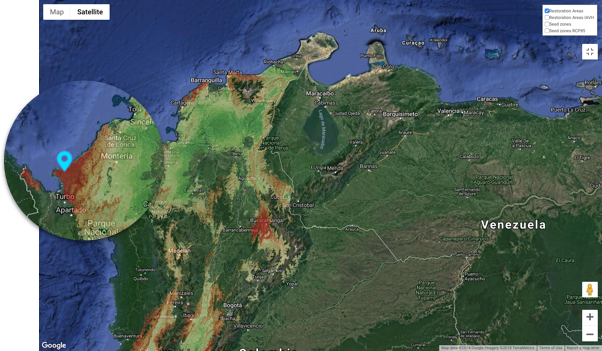Introduction
The restoration of degraded land is a global concern. To improve the effectiveness of forest restoration action, D4R was developed to help in the appropriate choice of species and identify seed sources for a given project site that meet the desired restoration objectives. D4R also takes into account climate change when choosing appropriate material, and includes information about the propagation of hundreds of tree species.
How does it work
-
As a first step the user is invited to identify the area to be restored on a map that shows the areas that are included in the D4R tool. These maps show the number of tree species expected to be able to survive under current and future climate conditions, according to the results of suitability modeling, which is illustrated using a scale from green (low number of tree species) to red (high number).
-
Next, the user is asked to fill in an online form with information about the conditions of the site targeted for restoration action, the restoration objectives, and additional options, e.g. how many and what type of species the user wishes to plant.
The tool selects species from a list of all possible species suited to the habitat of the planting site under current and future climate conditions. The user can specify the resource use strategies of the species (acquisitive species vs. conservative species). Furthermore one can manually limit the pool of species used, e.g. to restrict the tool to only consider species from a local inventory, or exclude exotic species.
To select appropriate species combinations, the tool screens the functional traits of those tree species that according to the suitability models are predicted to be able to persist at the chosen site and ranks them according to the trait profiles that best correspond to the restoration objectives and provide resistance against local stress conditions. With functional traits we refer here both to biological (morphological, physiological and reproductive traits among others) and non-biological traits (e.g. timber species, conservation status according to IUCN, etc.). The tool includes an optimization method that maximizes the functional diversity of the recommended species along with their suitability for the specified restoration objectives and resistance to local stress conditions.
-
Finally, the tool generates information on combinations of tree species that are expected to be adapted to the environmental conditions under current and future climatic conditions. The tool generates different options of species combinations, ranging from a higher focus on diversity to a higher focus on species suitability for the selected restoration objectives and resistance to local stress conditions. Seed zone maps are generated to indicate from which areas planting material should be sourced. The idea is that for each species, planting material is obtained both from local populations or populations growing under environmental conditions that are similar to those at the planting site, as well as from populations growing in areas with environmental conditions most similar to those that are expected to occur at the planting site in the future.
-
The results are provided to the user as a report that can be downloaded directly or received by email. The report is intended to serve as a guide for selecting appropriate species and seed sources for restoration of the specified site. Propagation protocols of individual species can be downloaded through hyperlinks. Recommended indicators for monitoring the success of restoration interventions are also included.
